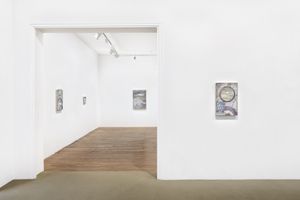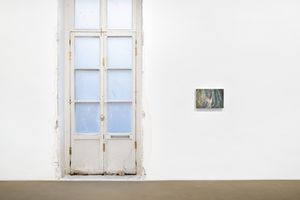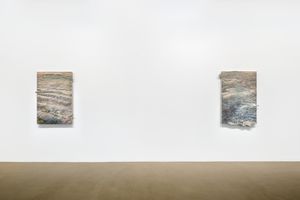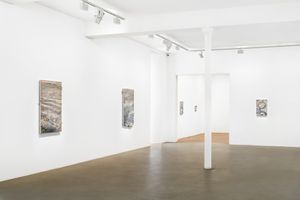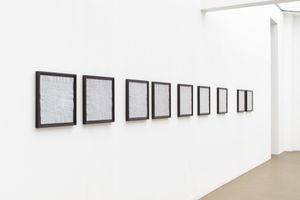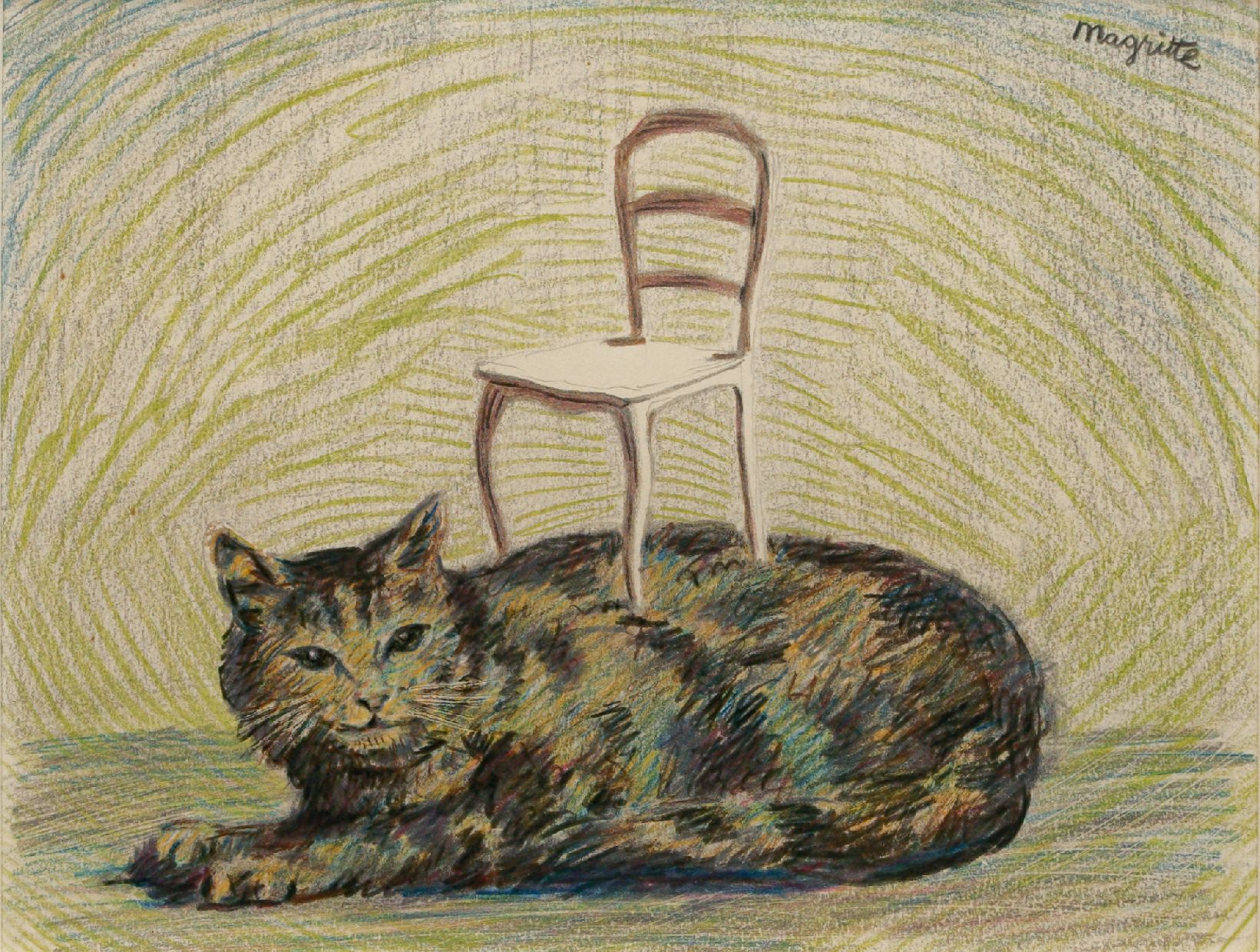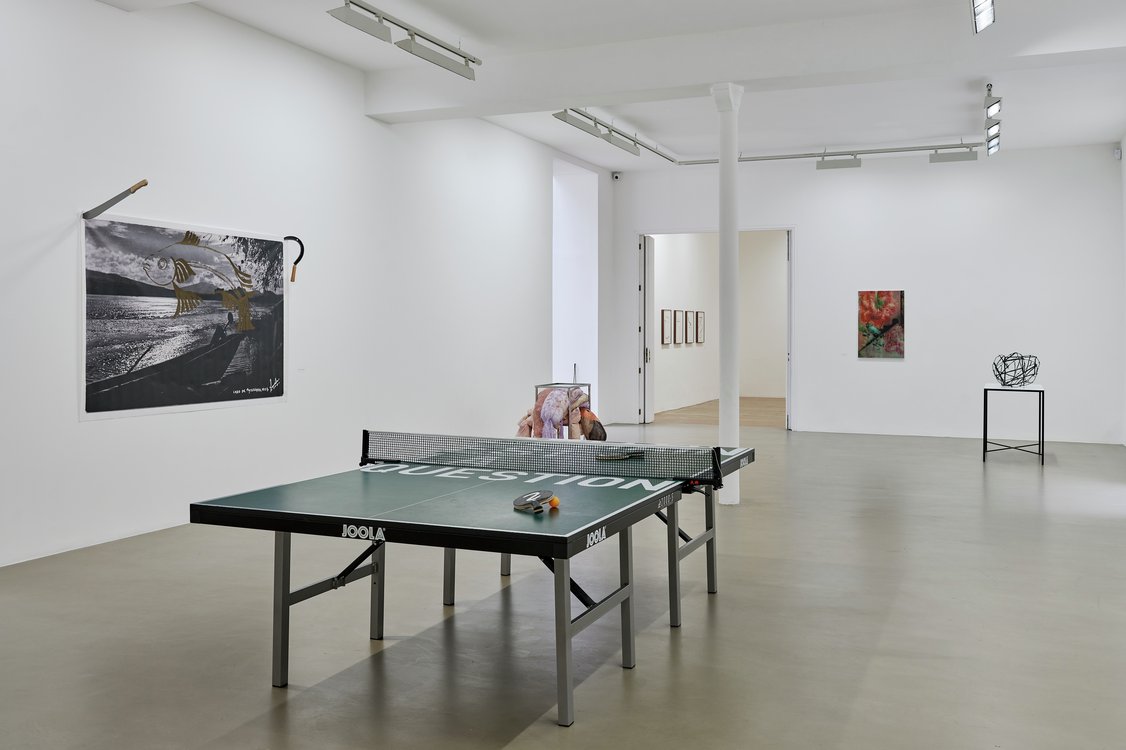Contemporariness is, then, a singular relationship with one’s own time, which adheres to it and, at the same time, keeps a distance from it. More precisely, it is that relationship with time that adheres to it, through a disjunction and an anachronism1—Giorgio Agamben
Galerie Chantal Crousel is delighted to host Anri Sala’s sixth exhibition at the gallery, featuring a body of unprecedented frescoes. The artist is pursuing his research into composition and chronology of the narratives, developed among others through his films and sound installations. With a mounting process, he rearranges temporal spaces and reverses our cognitive and visual perception.
Anri Sala's frescoes, conceived with the a fresco technique, merge various geological and historical temporalities. This ancient technique, almost anachronistic, unfolds equivocally over time and requires total temporal acuity. Each composition is divided into giornata, corresponding to what can be accomplished in a day of work while the medium, called the intonaco, remains fresh. Once it is dry, the pigments are bound to the worked surface and changes are no longer possible. The artist’s every gesture affixes the material like a temporal imprint, fossilizing the color and creating a form of contemporary archeology.
Pieces of marble embedded in the flat surface of the works are reminiscent of missing fragments of fresco, worn away over time. They are traditionally covered with raw plaster, accentuating the lacunae, or are restored by applying new shades of color to distinguish the recent conservation from what once was. Juggling with the geological references and mineral qualities of the various materials he uses, Anri Sala switches out some parts of the giornata with stones formed over the course of millennia. Sedimentary accumulation bridges the gap with present time and intermingles in the works that punctuate the gallery space.
The series Surface to Air derives from photographs taken by the artist of clouds seen from up in the air. These nearly abstract representations bear witness to a shifting, elusive reality. The undulating movement of the clouds harmonizes with the sharply delineated veins of the marble, a witness to a tangible and immutable temporal reality. With this series, Anri Sala juxtaposes elements of an ostensibly opposite nature, arranging them into a subtle visual continuity. The artist harnesses the suspense that arises from this unexpected encounter and opens up a latent, plural state of things.
The cycle of frescoes Piero della Francesca made for the Bacci Chapel in the San Francesco d’Arezzo basilica in Tuscany acts as a starting point for the Legenda Aurea series. This mid-fifteenth century cycle depicts the Legend of the True Cross recounted by Jacques de Voragine in Legenda aurea, his anthology of hagiographic legends. The images Anri Sala takes from this work are subjected to a process of reversal, in which the positive becomes negative, the dark areas become luminous, the skin tones blueish. This highly novel shift enables the artist to transpose the modern process of colorimetric negative, which only exists in photography, onto the fragments of a Quattrocento masterpiece. The eye is thus struck by the dissonance of this encounter between two techniques having distant temporal and spatial realities.
Working from reproductions, Anri Sala removes details to create a photographic painting whose tight framing offers a glimpse of a narrative outside the frame. In Legenda Aurea Inversa (VI, fragment 1ii), two hands are holding a rope connected to an action, which is only partially visible, leaving a space for the gesture’s potential future. With Legenda Aurea Inversa (VII, fragment 1), Legenda Aurea Inversa (VII, fragment 4), and Legenda Aurea Inversa (VII, fragment 2), all of which were inspired by the same scene, it no longer entails a linear narrative sequence but rather a fragmented one, with the story’s ellipses giving way to geological time. The successive slices of marble from a single block inject the works with another chronology. “When we think about looking or reading, whether it’s a figurative painting, literature, or even film, we get the sense that the past, present, and future unfold before our eyes in a directional way. Even if time proceeds consecutively from a geological point of view, it’s the cutting angle of the stone, however, that slices through events, proposing a unique narrative2.”
In this series, the marble, volcanic stone, or even mother-of-pearl replace certain parts of the frescoes, playing on the geological qualities of the chosen materials, erosion, and the juxtaposed layers resulting in “strata of time2” Reproducing a bullet shot on the Bacci Chapel fresco, a discreet witness to the Napoleonic Wars waged in Tuscany at the turn of the nineteenth century, the work Legenda Aurea (II, 1799/1800) achieves a balance between figuration and abstraction, by exploring the meanderings of history and superimposing time intervals.
Below the glass roof of the gallery, Anri Sala is showing Tracing Vista, a series of works on paper made from the tracing paper used to transfer the drawings onto the freshly applied intonaco. Along the line traced by the artist, pieces of plaster stick to the sheet when it is removed. Inverting the narrative reveals a stratification process that continues onto the paper, beyond the mineral elements and various temporalities comprising the fresco: an ultimate extension of geological time. Fragmentarium III (Afternoon Slightly After), made up of intonaco fragments from the structural cracks formed after the completion of a giornata, belongs to this same archeological process. Akin to artifacts and buried vestiges uncovered in an archeological dig, these “shattered days2” are so many fossils preserving the memory of an image in the process of being made.
Anri Sala would like to express his gratitude to the following people for their specific and crucial involvement in this exhibition: Gianmarco Biele, Erika De Gennaro, Alessandra Falcone & Domenico Russo, Caroline Vandamme.
—
1 Giorgio Agamben’s “What Is the Contemporary?” from What is an Apparatus? and Other Essays, trans. David Kishik and Stefan Pedatella (Stanford University Press, 2009).
2 Artist's quotes.
